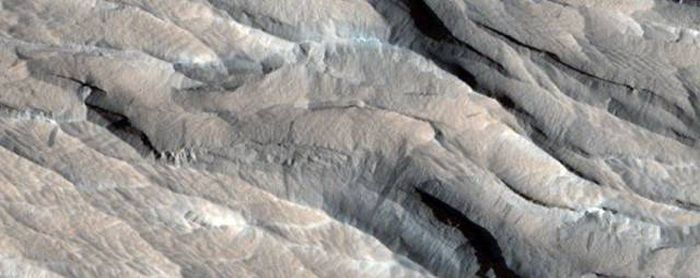|
|
Mars Photography By Mars Reconnaissance Orbiter
|
MRO began orbital insertion by approaching Mars on March 10, 2006, and passing above its southern hemisphere at an altitude of 370–400 kilometres (230–250 mi). All six of MRO's main engines burned for 27 minutes to slow the probe from 2,900 to 1,900 metres per second (9,500 to 6,200 ft/s). The helium pressurization tank was colder than expected, which reduced the pressure in the fuel tank by about 21 kilopascals (3.0 psi). The reduced pressure caused the engine thrust to be diminished by 2%, but MRO automatically compensated by extending the burn time by 33 seconds.
Completion of the orbital insertion placed the orbiter in a highly elliptical polar orbit with a period of approximately 35.5 hours. Shortly after insertion, the periapsis – the point in the orbit closest to Mars – was 3,806 kilometres (2,365 mi) from the planet's center (426 kilometres (265 mi) from its surface). The apoapsis – the point in the orbit farthest from Mars – was 47,972 kilometres (29,808 mi) from the planet's center (44,500 kilometres (27,700 mi) from its surface).
On March 30, 2006, MRO began the process of aerobraking, a three-step procedure that cuts in half the fuel needed to achieve a lower, more circular orbit with a shorter period. First, during its first five orbits of the planet (one Earth week), MRO used its thrusters to drop the periapsis of its orbit into aerobraking altitude. This altitude depends on the thickness of the atmosphere because Martian atmospheric density changes with its seasons. Second, while using its thrusters to make minor corrections to its periapsis altitude, MRO maintained aerobraking altitude for 445 planetary orbits (about 5 Earth months) to reduce the apoapsis of the orbit to 450 kilometres (280 mi). This was done in such a way so as to not heat the spacecraft too much, but also dip enough into the atmosphere to slow the spacecraft down. After the process was complete, MRO used its thrusters to move its periapsis out of the edge of the Martian atmosphere on August 30, 2006.
In September 2006 MRO fired its thrusters twice more to fine-tune its final, nearly circular orbit to approximately 250 to 316 kilometres (160 to 196 mi) above the Martian surface. The SHARAD radar antennas were deployed on September 16. All of the scientific instruments were tested and most were turned off prior to the solar conjunction which occurred from October 7 to November 6, 2006. After the conjunction ended the "primary science phase" began.
|
|









